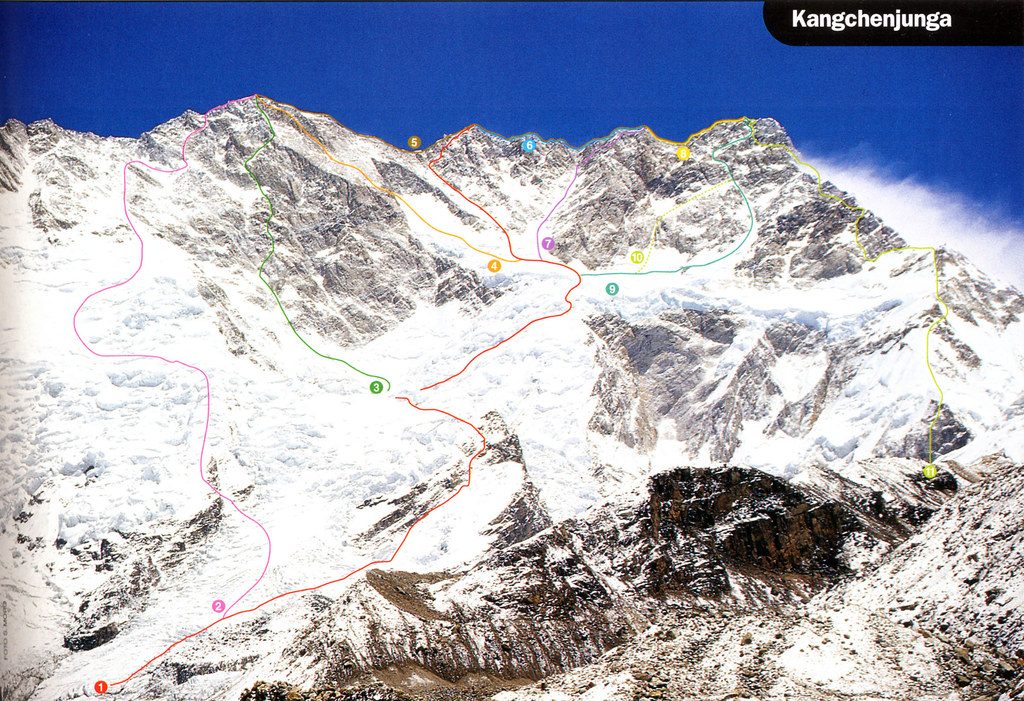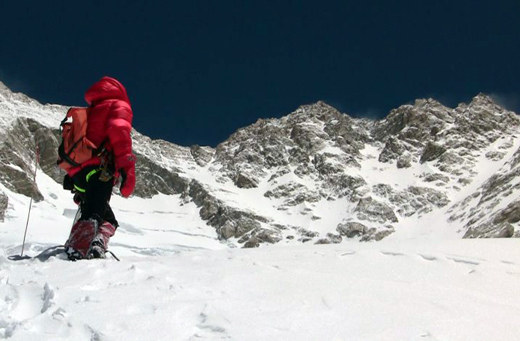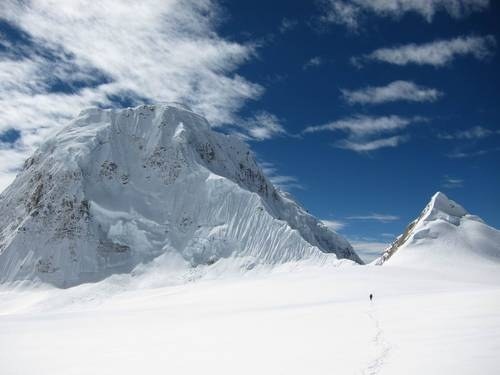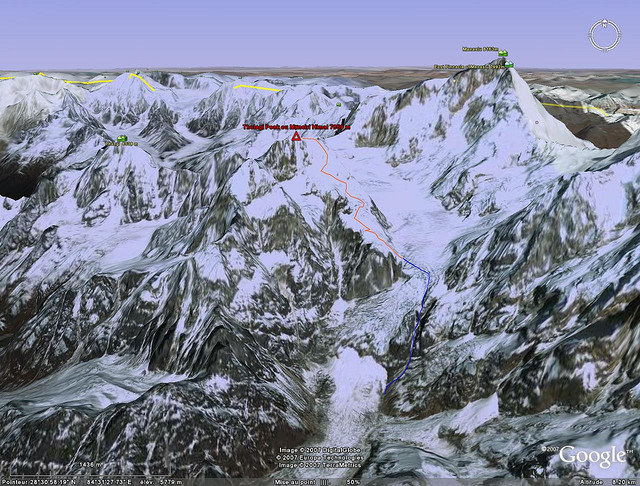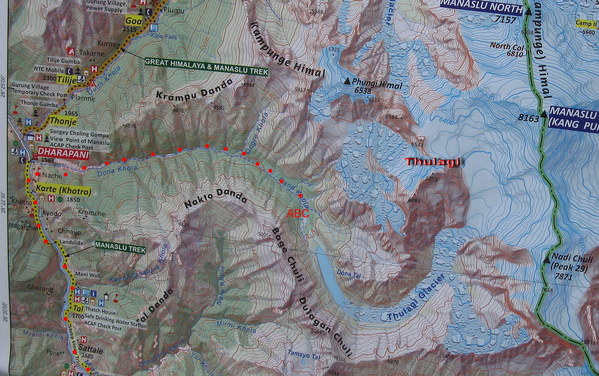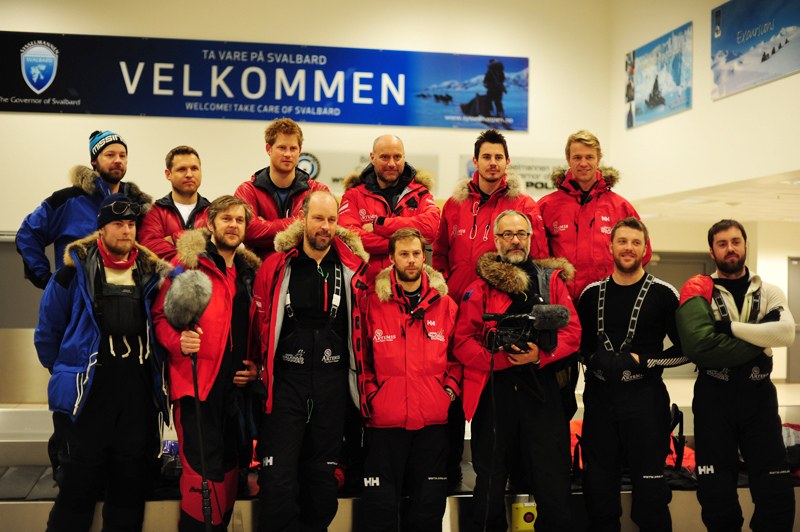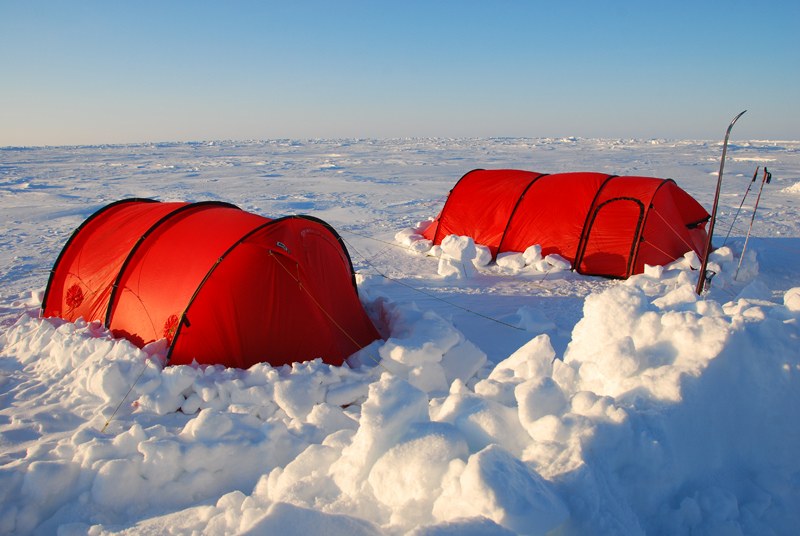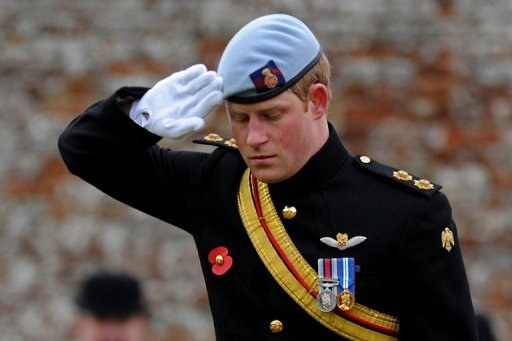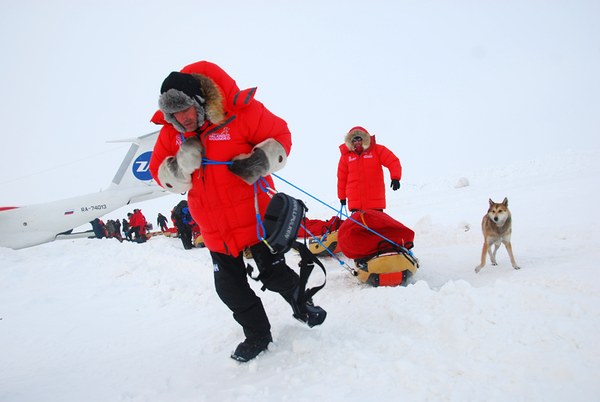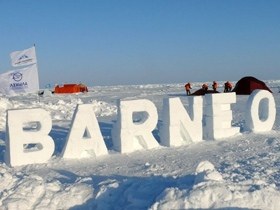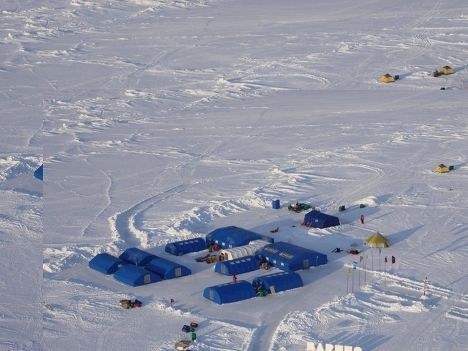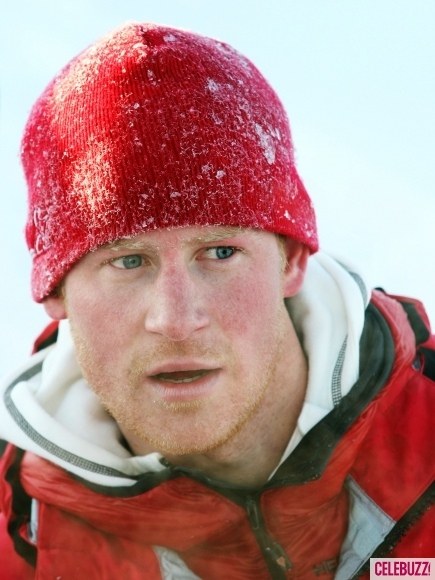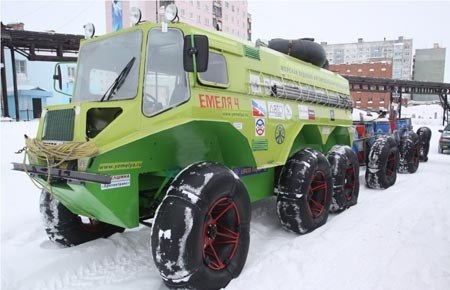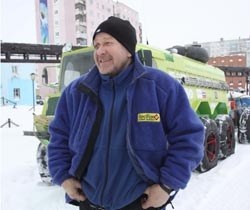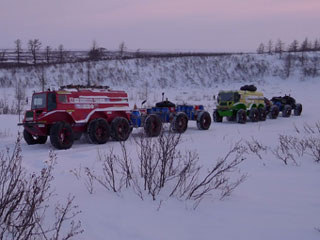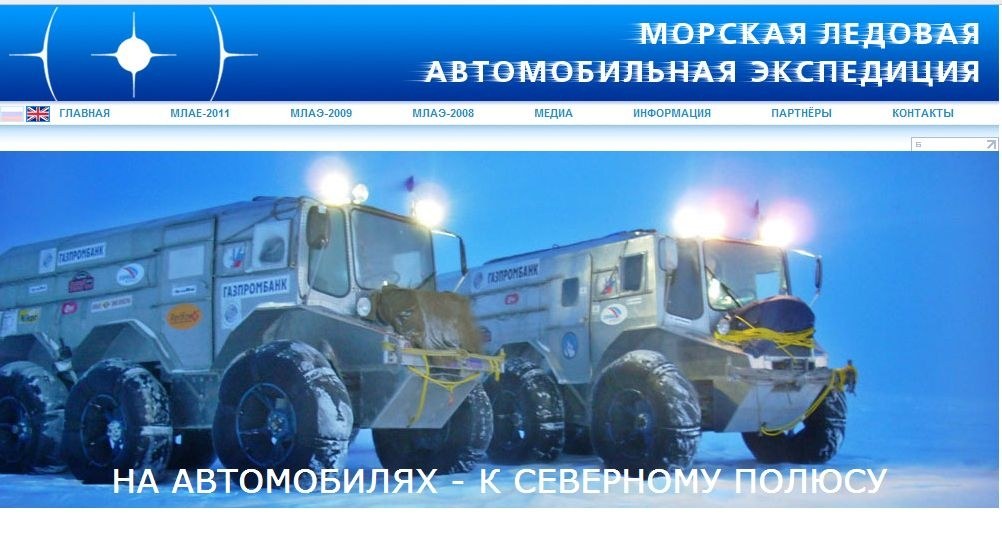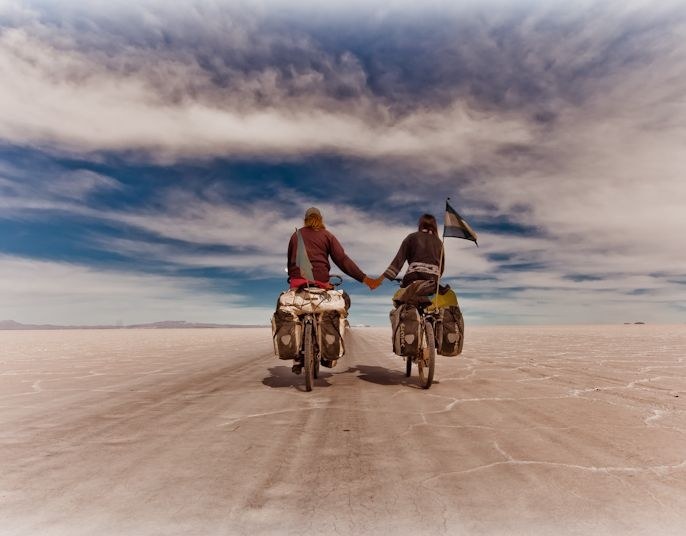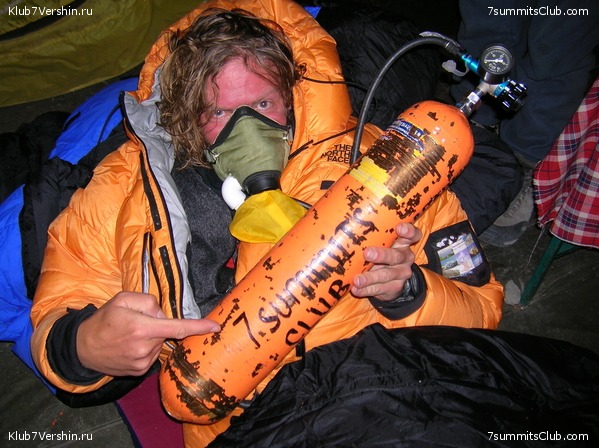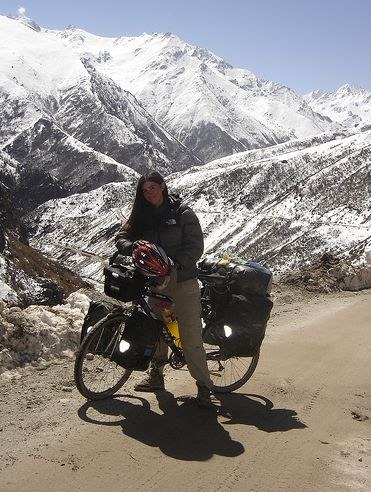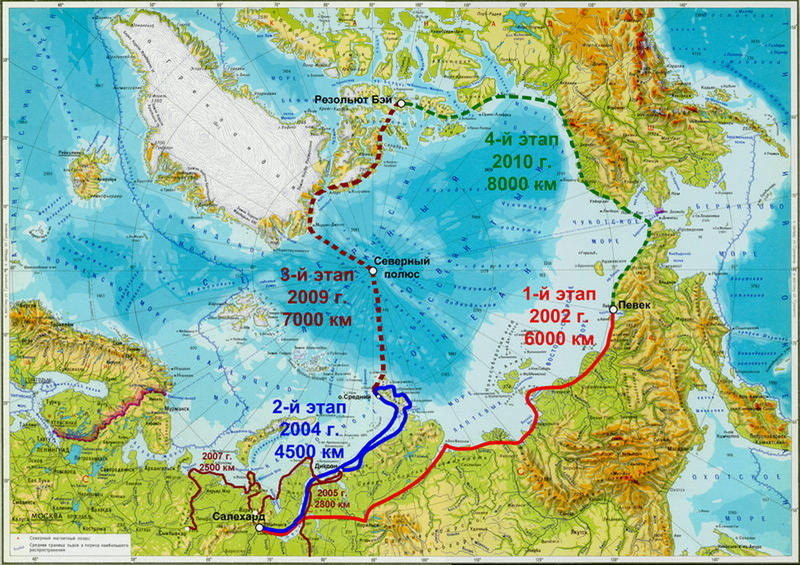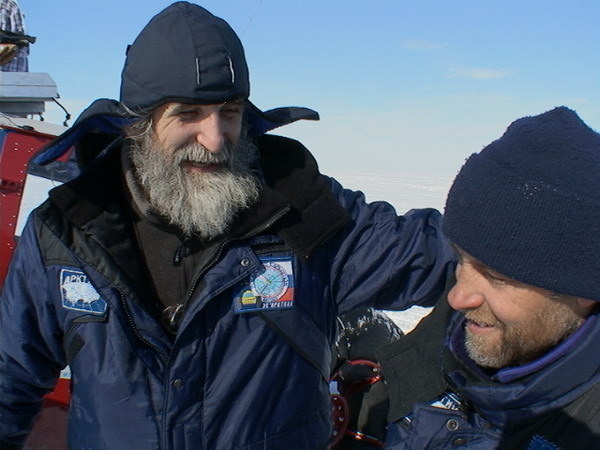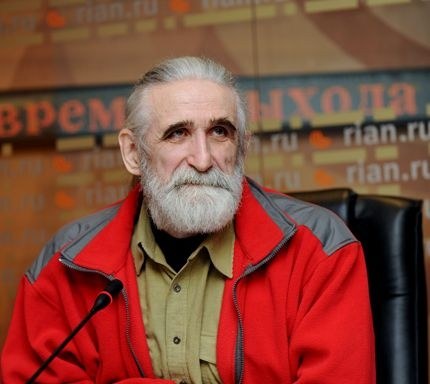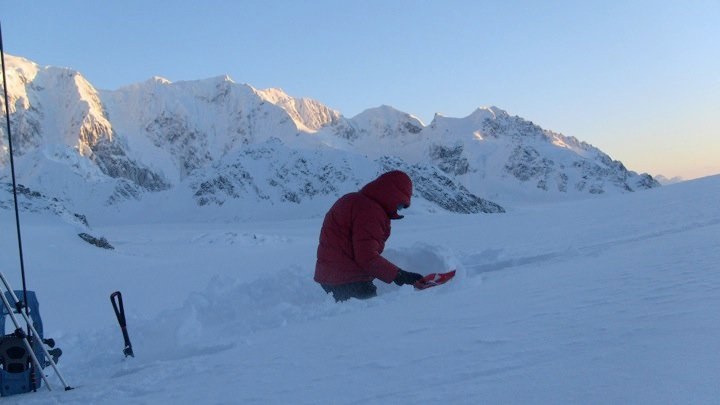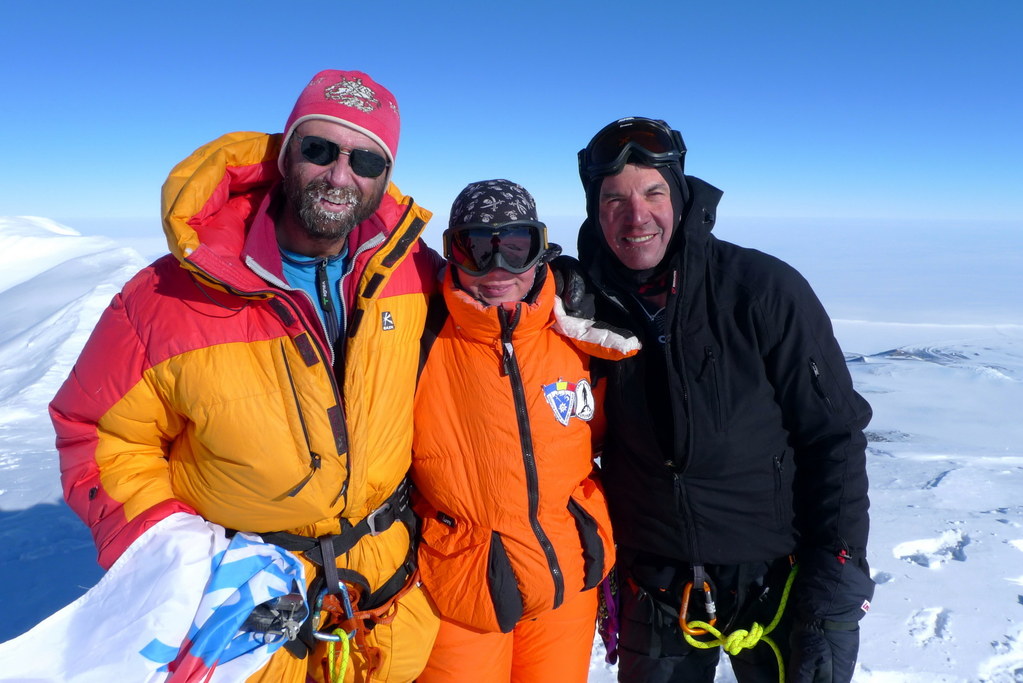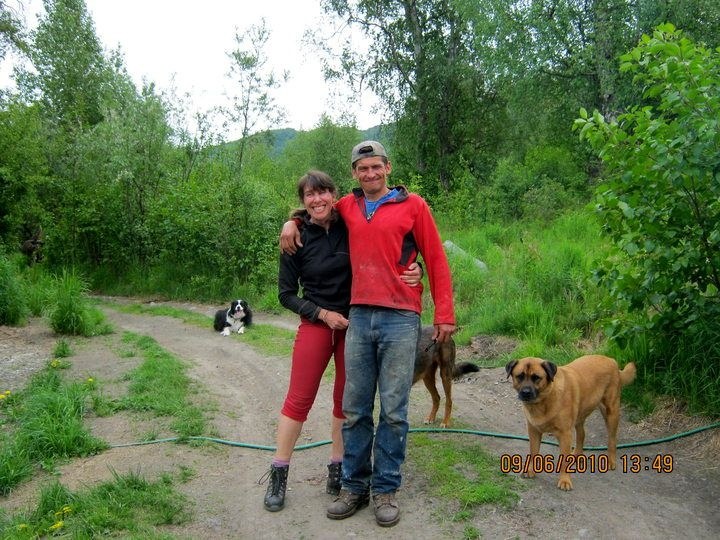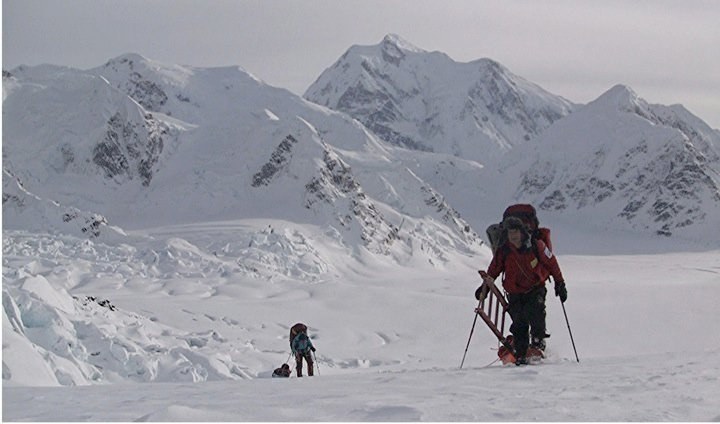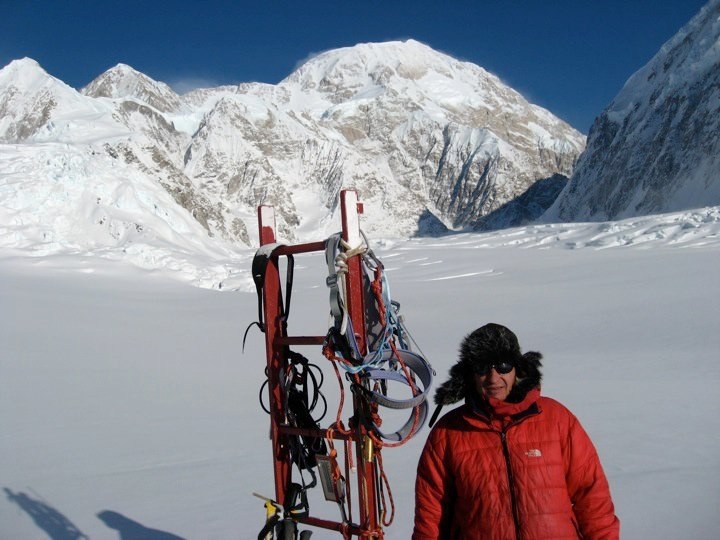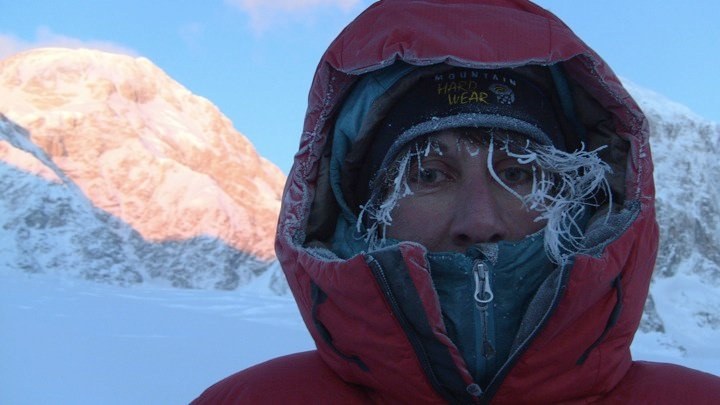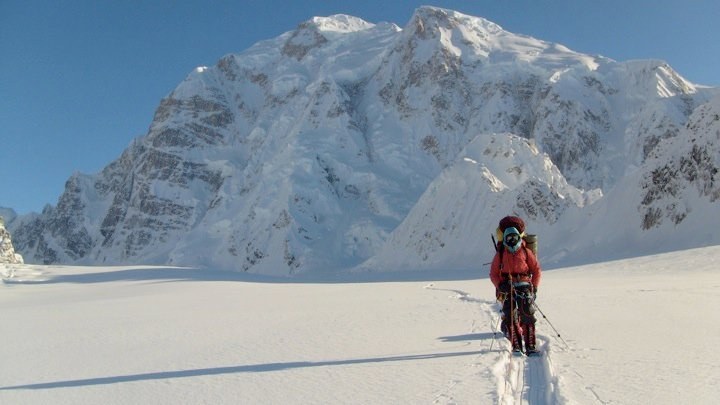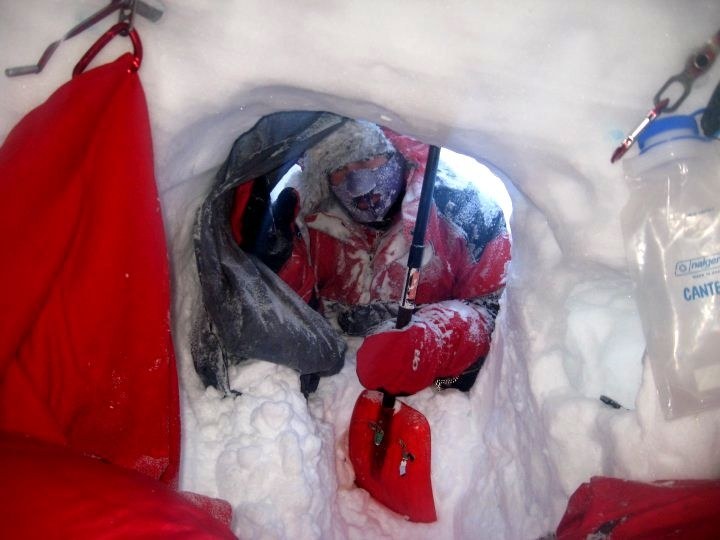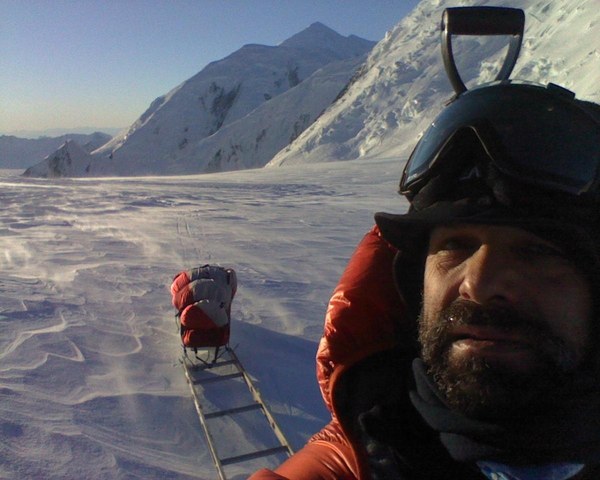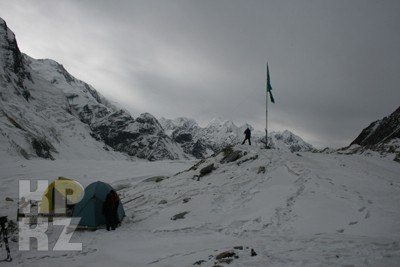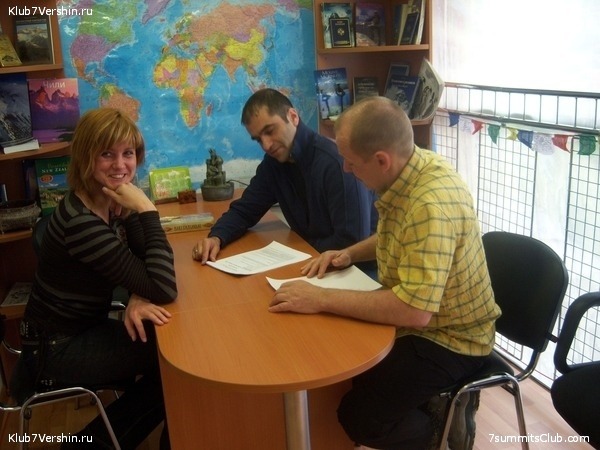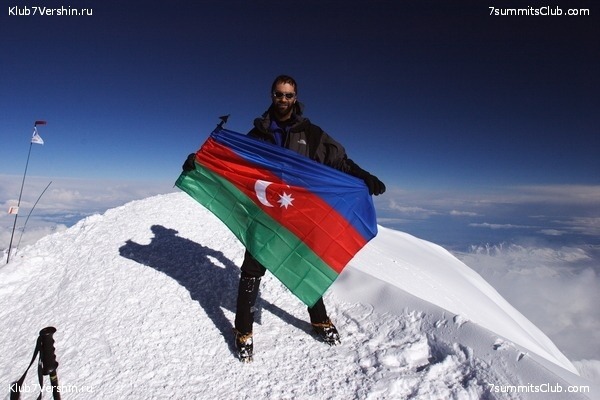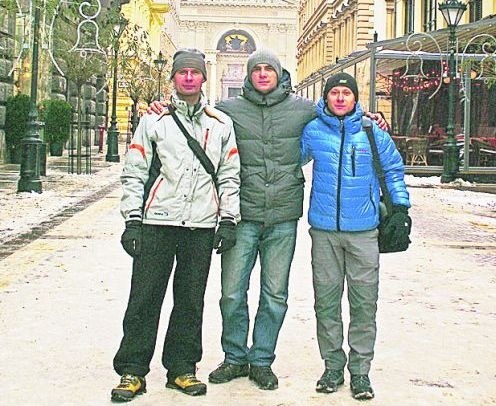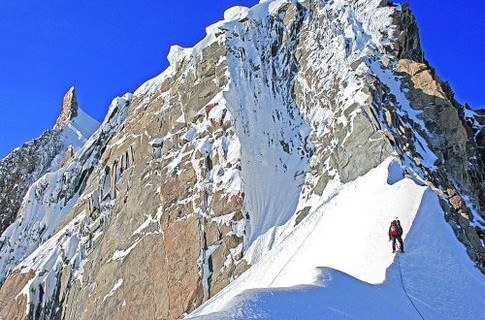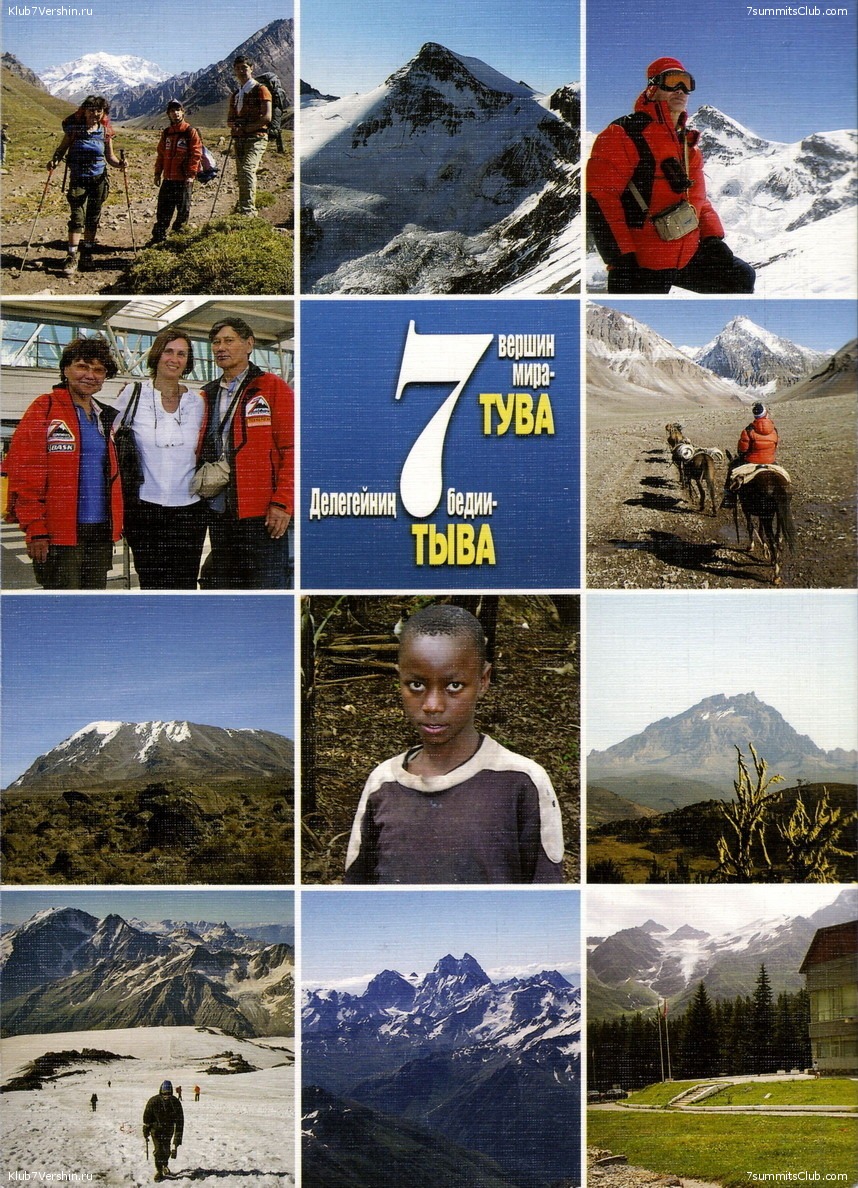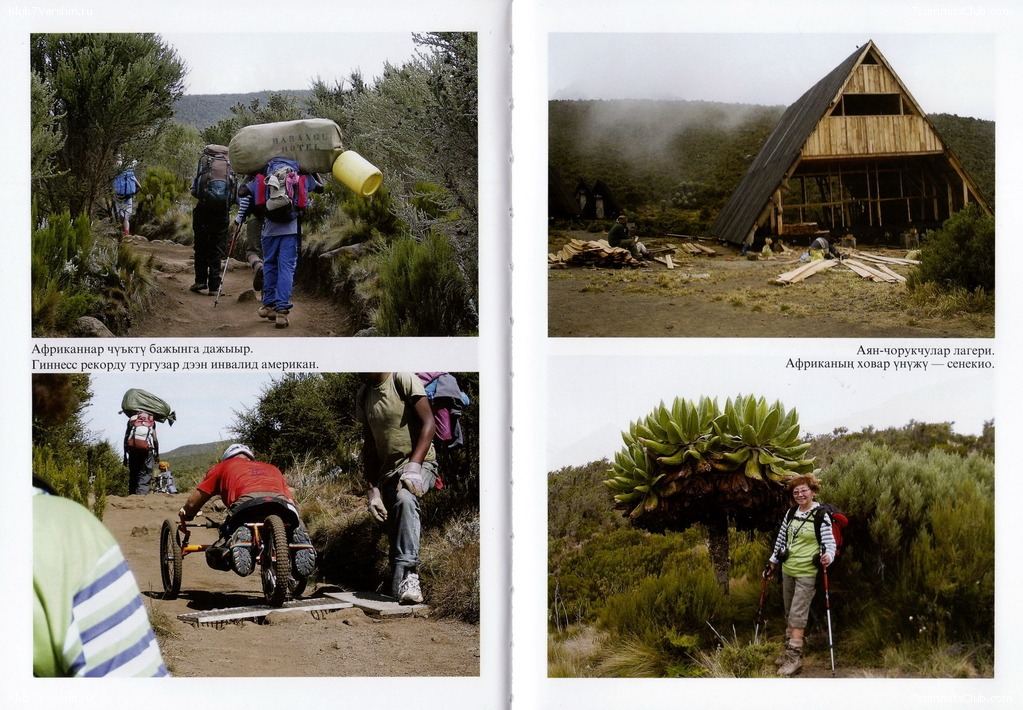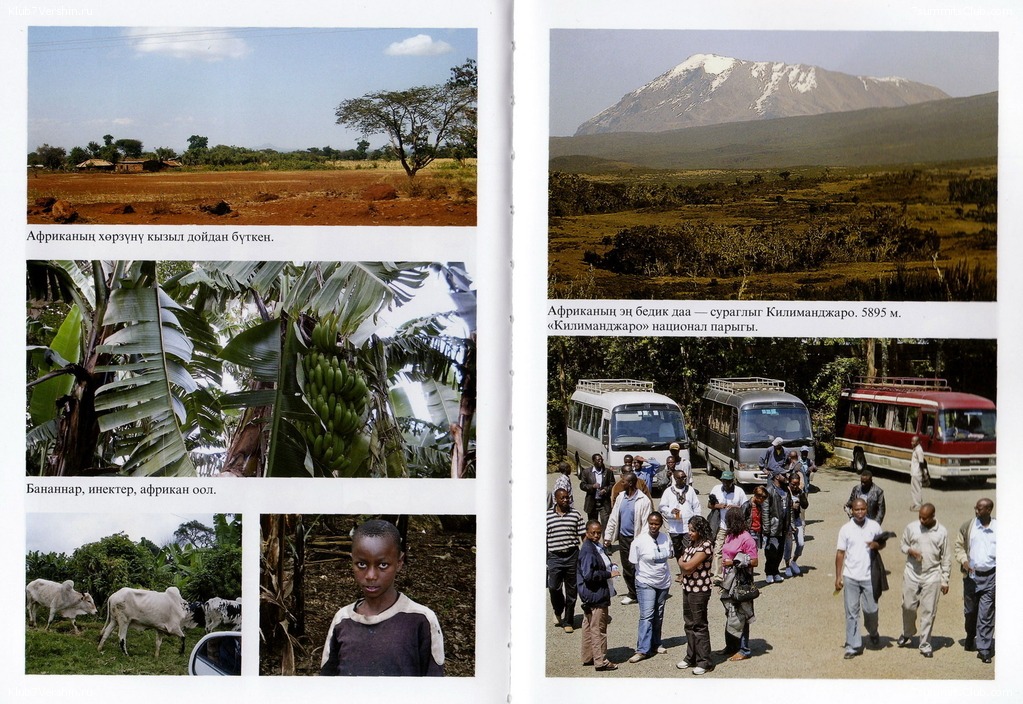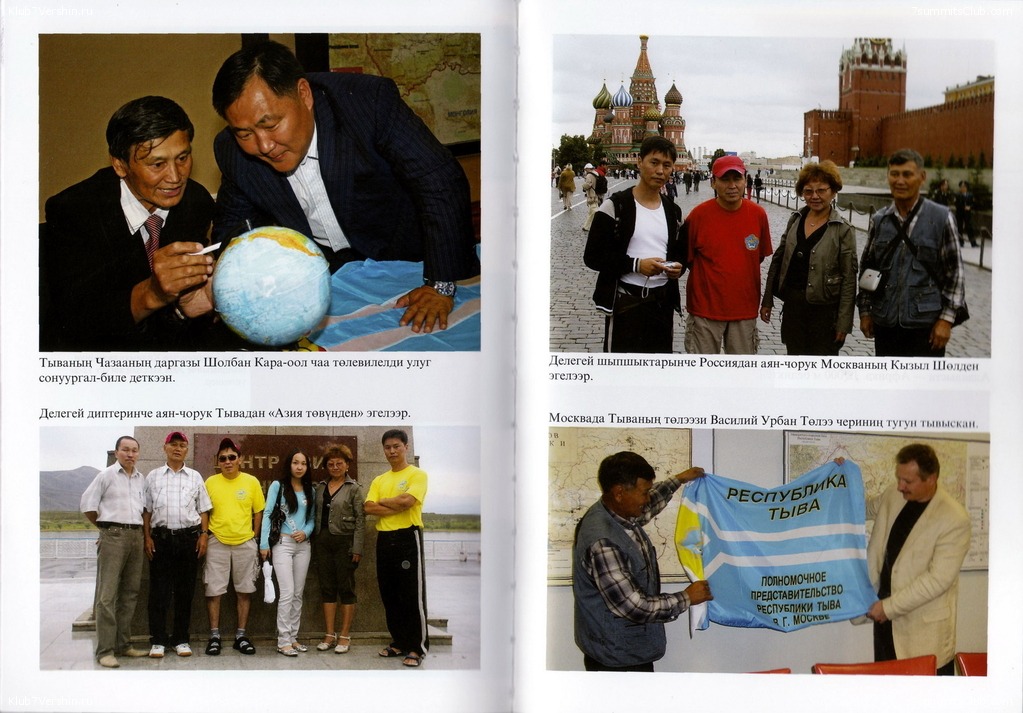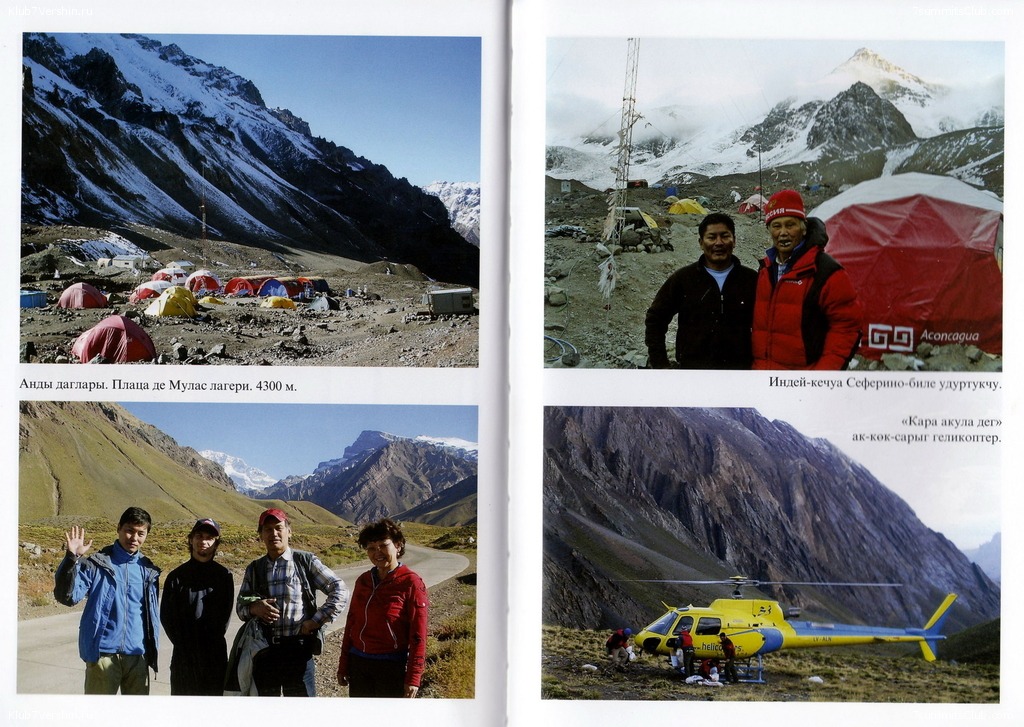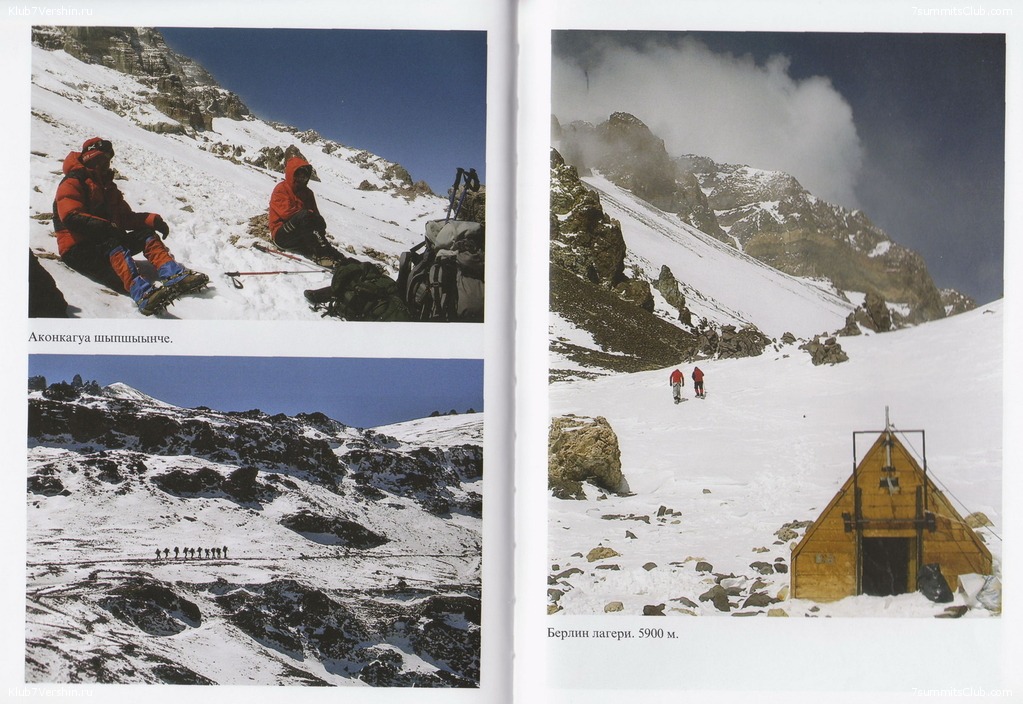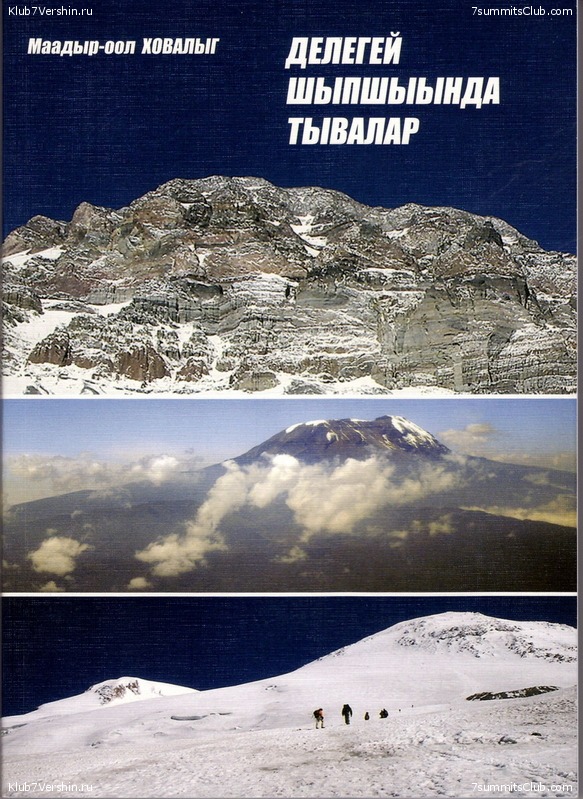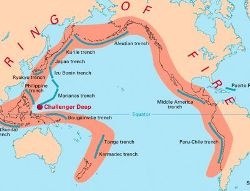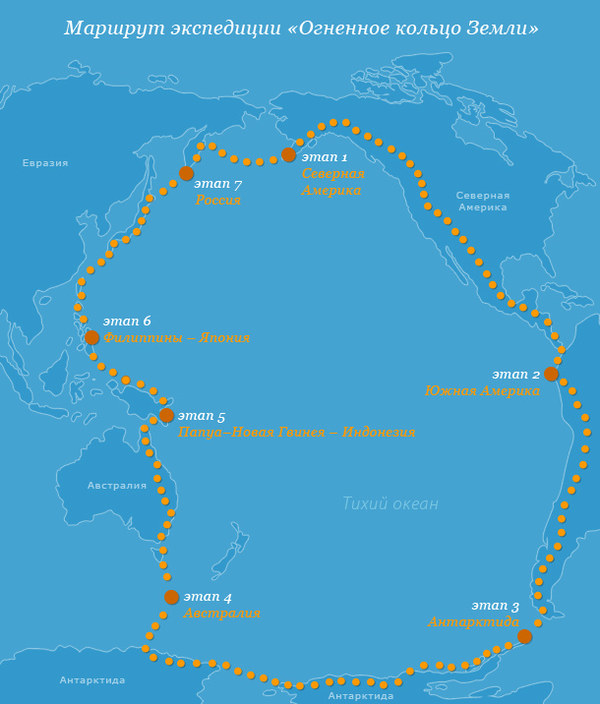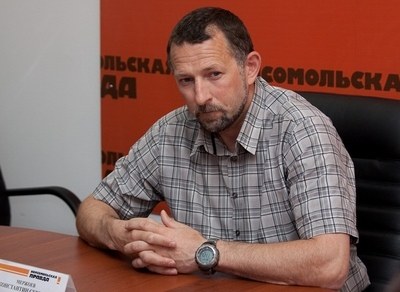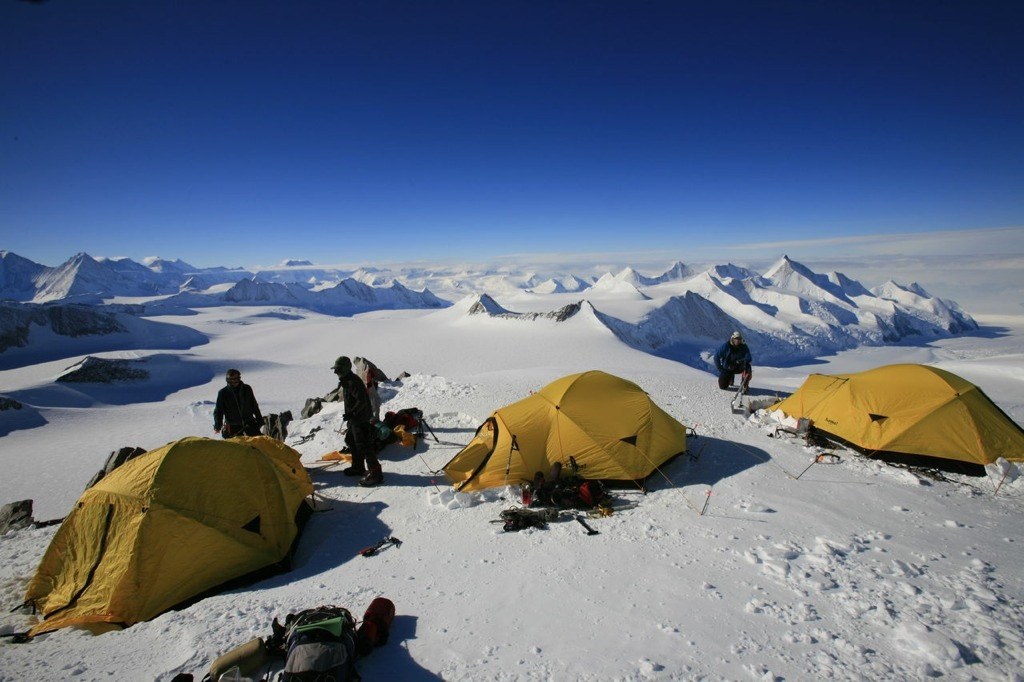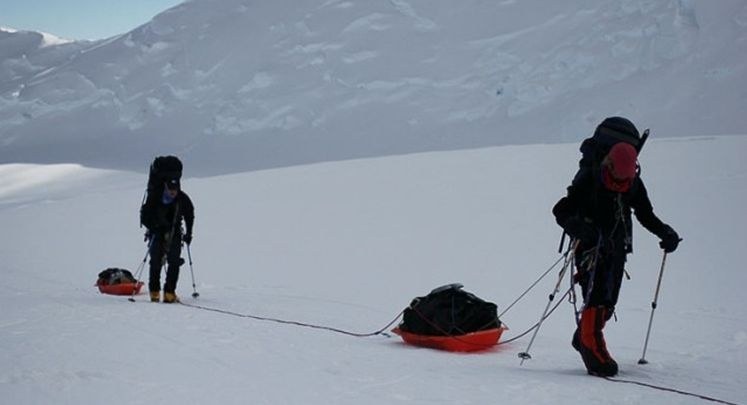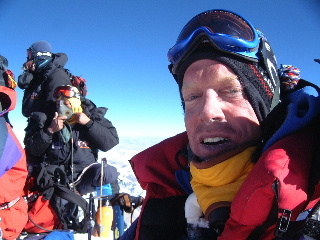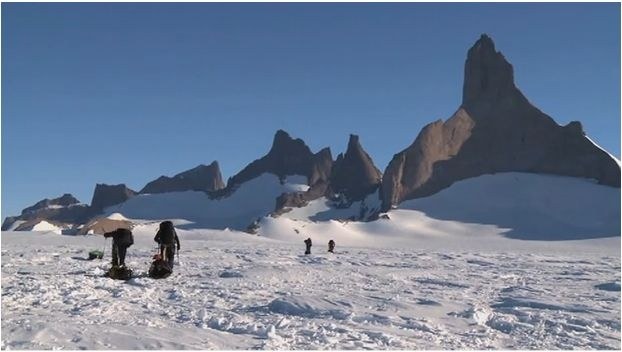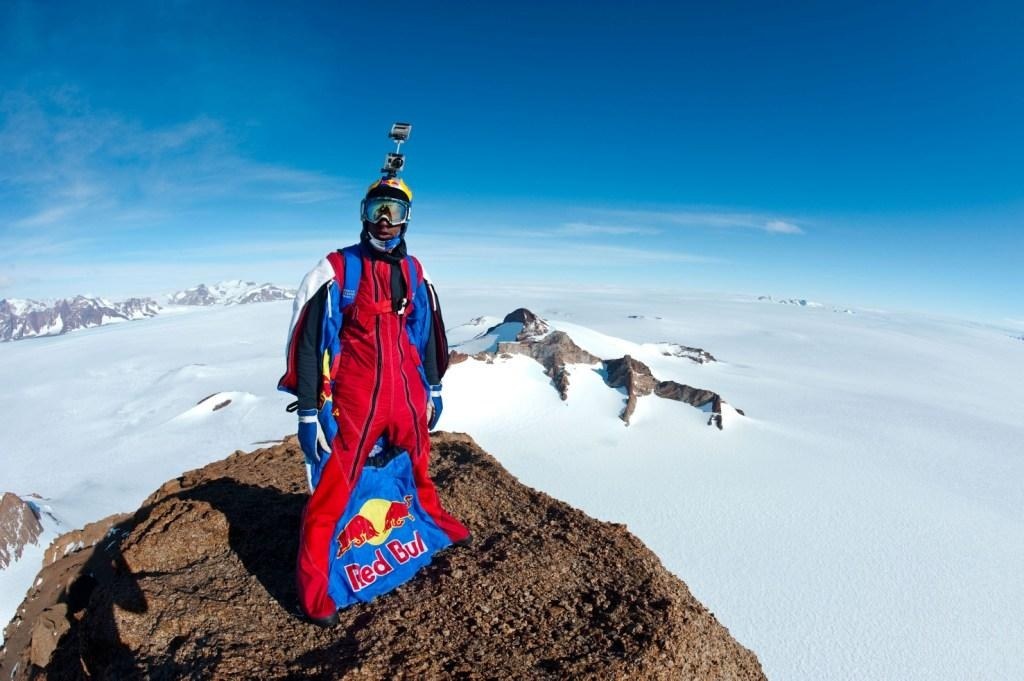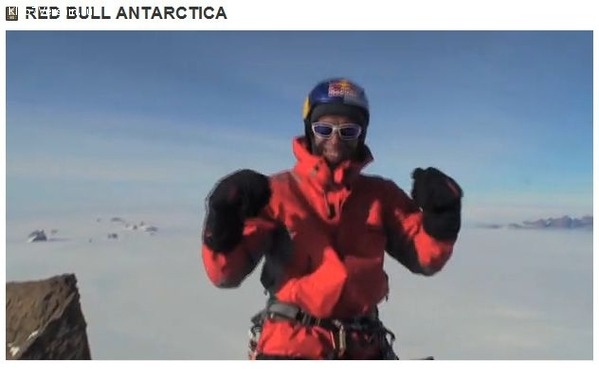Our Club's friends expeditions
Successful Kangchenjunga summit push !
Anna Gatta reports: I just got a phone call from Philippe at camp 4, 7700m. Philippe Gatta, Ludovic Chaleat, Cédric Haelen and 3 Sherpas successfully made a camp 4-summit-camp 4 round trip this night/morning in 11 hours (timing to be ...
Anna Gatta reports: I just got a phone call from Philippe at camp 4, 7700m. Philippe Gatta, Ludovic Chaleat, Cédric Haelen and 3 Sherpas successfully made a camp 4-summit-camp 4 round trip this night/morning in 11 hours (timing to be confirmed, line was bad). Kangchenjunga, 8586m, is bagged!
Alexia and Ben turned around at 8200m and is now walking down towards camp 3 or even camp 2. The are both fine but I think they felt too tired to go on. Gorgan didn’t feel good enough to start the summit push and went down and might even be in base camp already. Conclusion – everyone are ok, that is what counts.
Christian Stangl and a Russian guy also made the summit.
Philippe will stay in camp 4 today to recover from the tough night and tomorrow everyone will be back in base camp.
Search on for Belarusion climbers!
May 15th, 2011 by fishtailair. On the 14th and 15th May, we had done aerial search on Thulagi Peak 7057 m (which is also called Mansiri Himal). The mountain had been scouted in the entire altitude, from the top till the bottom in all ...
May 15th, 2011 by fishtailair. On the 14th and 15th May, we had done aerial search on Thulagi Peak 7057 m (which is also called Mansiri Himal). The mountain had been scouted in the entire altitude, from the top till the bottom in all the faces. No life could be seen and today 15th we saw a tent at around 6300 m. It was dark green in color, and it was located on the south face. We landed and one of our rescuers jumped out from the helicopter and went inside the tent. There were sleeping bags and some equipment but no human sign. Few pieces of equipment have been taken as a proof of our research to be recognized by the family. When we took off from that place (6300 m) and we found some footprints above the tent, ending in a sharp ridge. We searched a lot below that ridge and above. We also went to other directions starting from other potential climbing routes but nothing could be found. From my climbing experience I’m quite sure that they fell in a crevasse or from that ridge because that place was really dangerous.
Wounded soldier reaches north pole with charity trek team
North Pole.
A soldier from Widnes, who has a paralysed arm after being shot in Afghanistan, has reached the north pole after a 13-day trek. Capt Martin Hewitt, 30, reached the pole on Saturday, 16 April with the Walking With The Wounded team. Prince ...
A soldier from Widnes, who has a paralysed arm after being shot in Afghanistan, has reached the north pole after a 13-day trek. Capt Martin Hewitt, 30, reached the pole on Saturday, 16 April with the Walking With The Wounded team. Prince Harry, the patron of the charity, joined the team for the first four days of the expedition.
It is the first time a group of servicemen with such serious injuries have reached the north pole unaided. Capt Hewitt, who was part of the six-man team, said: "It was a fantastic experience, it really was. It was unique.
"Just prior to us getting to the pole, we stopped 400 metres short and got into a line abreast and walked across together. "The ice is constantly moving, so you're looking for the point.
The Walking With The Wounded team reached the north pole unaided "That took us a little bit of time, but then the moment came when the guide turned around and said, 'boys, you're standing on the geographical north pole'.
"I felt a huge sense of relief that we'd made it, that we'd done it."
Capt Hewitt pulled a 220lb (100kg) sled for more than 170 miles (274 km) in the trek and with ice as hard as concrete, any falls by the soldiers could have meant the end of the expedition.
"An element of luck was involved with this, as with any expedition of this nature when the variables are out of your control - the weather, Mother Nature herself," he said.
"You need a bit of Lady Luck on your side."
Capt Hewitt was commissioned into the Parachute Regiment in 2004 and commanded a rifle platoon.
He was shot in the shoulder during combat in 2007. The bullet severed an artery and all nerves to his right arm.
The soldier also suffered a collapsed lung and a shattered shoulder blade and needed two life-saving operations in Camp Bastion.
Capt Hewitt then spent six weeks in hospital in the UK, followed by rehabilitation at Headley Court in Surrey.
Arctic expedition with Prince Harry starts
Prince Harry and four disabled Afghan war veterans will finally set off for the North Pole on Mondayafter severe gales postponed their intrepid charity expedition by 48 hours. Harry, who is a benefactor of the Walking with the Wounded ...
Prince Harry and four disabled Afghan war veterans will finally set off for the North Pole on Mondayafter severe gales postponed their intrepid charity expedition by 48 hours.
Harry, who is a benefactor of the Walking with the Wounded charity, joined the team on the Norwegian island of Spitsbergen last week. The expedition plans to raise $3.2 million to help wounded troops.
Harry's four fellow travelers, two of them amputees, hope to enter the record books as the first handicapped group to hike unassisted to the North Pole.
"We've spent plenty of days living on top of each other, so I feel like I'm one of the team now," Prince Harry said.
The prince will travel with the expedition for five days and then will be picked to return home for his military commitments.
The Chronicles of transpolar expeditions
North Pole.
24 March 2011. Blizzard lasted for four days, warm - up to -7 C °, drifting snow, white-out, a strong wind. The Arctic has prepared for our verification of the entire set of its surprises. On low speed we move through with ...
24 March 2011. Blizzard lasted for four days, warm - up to -7 C °, drifting snow, white-out, a strong wind. The Arctic has prepared for our verification of the entire set of its surprises. On low speed we move through with clenched teeth, and pushing his views are more in the Navigator screen and the computer with the card than the windshield, get to the northern tip of Island Russky. Machines behave well, the team, too, going round the clock, and if the watch falls on the dark, it is considered good luck, as in the light of powerful lights landscape of snow and ice ridges are seen better than in the afternoon milk.
MLAE-2011 is short for Marine Live-ice Automobile Expedition 2011. It is organized under the patronage of Arthur Chilingarov – Special representative of President of Russian Federation for international cooperation in the Arctic and the Antarctic.
RCAE is short for Russian Center for Arctic Exploration – an Autonomous Non-profit Organisation which is developing innovative amphibious automobiles “YEMELYA” and organizing expeditions in High Arctic.
This year March 4, 2011 our team had started from town of Urengoy in Yamalo-Nenetskij Autonomous Region of Russia and is driving up to the North Pole (approximately until April 20) and further to Ward Hunt Island, Canada (supposingly by May 26) and will finish in the town of Resolute, Nunavut, Canada (probably by May 31) plus a few days spare. From Resolute Bay we shall fly to Montreal before we can fly home to Moscow.
For the expedition we shall use newly built automobiles “Yemelya-3” and “Yemelya-4”. We plan to leave them in Resolute Bay for a period of 10 months until March 2012 when we plan to return to Nunavut from Russia and continue the route of the expedition further on along the coastline of Canadian Arctic to Alaska.
During previous expedition MLAE-2009 – seven-men crew: Vasily Elagin Afanassi Makovnev, Vladimir Obihod, Sergey Larin, Alexey Shkrabkin, Alexey Ushakov, Nikolai Nikulshin in two automobiles “Yemelya-1” and “Yemelya-2” under the leadership of Vasily Elagin had started from Severnaya Zemlya, Russia and after 38 days and 2033 km of driving over drift ice for the first time in history of Arctic exploration reached the North Pole by car. It happened on April 26, 2009 and now this achievement is included into Russian Book of Records.
Barneo 2011 press conference
North Pole.
On 21 March, a press conference was held to present the high-latitude Arctic expedition Barneo 2011; the two venues, in Moscow and St. Petersburg, were linked by a multimedia “video bridge”. This year Barneo 2011 is sponsored by ...
On 21 March, a press conference was held to present the high-latitude Arctic expedition Barneo 2011; the two venues, in Moscow and St. Petersburg, were linked by a multimedia “video bridge”.
This year Barneo 2011 is sponsored by the Russian Geographical Society. Since 2002, the Barneo ice camp ensures Russian presence in the North Pole region. The base is maintained by Polius Expeditionary Centre of the Russian Association of Polar Explorers.
The press conference participants in Moscow included Artur Chilingarov, Russian President’s special representative for international cooperation in the Arctic and Antarctica and the First Vice-President of the Russian Geographical Society; Alexander Orlov, Head of Barneo 2011 expedition and Vice-President of the Russian Association of Polar Explorers; and Dmitri Shparo, leader of “Skiing to the North Pole!” youth expedition.
In St. Petersburg the press conference was attended by Victor Boyarsky, Director of the Arctic and Antarctic Museum; Vladimir Strugatsky, Vice-President of the Russian Association of Polar Explorers; and Viacheslav Makeyev, Head of Nature Management Department at the State Polar Academy.
Currently the expedition is getting ready for the logistics stage. Building on the Soviet polar explorers’ experience and using their own innovative approaches and designs, Polius Expeditionary Centre plans to set up the Barneo ice camp in the early April. Barneo base will work for a month, performing various operations. In 2011 the camp expects to receive more than 300 tourists who’ll have a chance to reach the North Pole.
Two research teams will be working at the station. Members of the Arctic and Antarctic Research Institute will work according to their research programmes on a drifting ice floe. The PanArctic Ice Camp Expedition (PAICEX) of the Shirshov Institute of Oceanology of the Russian Academy of Science will carry on for the fifth year running. And for the fourth year in a row, youth skiing expedition will go to the North Pole, led by Matvey Shparo and Boris Smolin.
http://int.rgo.ru/news/barneo-2011-press-conference/
Photographs by Yaroslav Nikitin and Darya Shlykova
The expedition reached Dickson, the last point on the mainland
North Pole.
March 16, after nearly two weeks of the way, the Marine Live-ice Automobile Expedition 2011 reached the village of Dixon. This destination on the mainland, then starts the actual crossing of the ocean. Our friends headed by the leader of ...
March 16, after nearly two weeks of the way, the Marine Live-ice Automobile Expedition 2011 reached the village of Dixon. This destination on the mainland, then starts the actual crossing of the ocean. Our friends headed by the leader of the expedition Vasily Yelagin tested equipment, entered into a rhythm and are ready for the main part of the route.
MLAE-2011 is short for Marine Live-ice Automobile Expedition 2011. It is organized under the patronage of Arthur Chilingarov – Special representative of President of Russian Federation for international cooperation in the Arctic and the Antarctic.
RCAE is short for Russian Center for Arctic Exploration – an Autonomous Non-profit Organisation which is developing innovative amphibious automobiles “YEMELYA” and organizing expeditions in High Arctic.
This year March 4, 2011 our team had started from town of Urengoy in Yamalo-Nenetskij Autonomous Region of Russia and is driving up to the North Pole (approximately until April 20) and further to Ward Hunt Island, Canada (supposingly by May 26) and will finish in the town of Resolute, Nunavut, Canada (probably by May 31) plus a few days spare. From Resolute Bay we shall fly to Montreal before we can fly home to Moscow.
For the expedition we shall use newly built automobiles “Yemelya-3” and “Yemelya-4”. We plan to leave them in Resolute Bay for a period of 10 months until March 2012 when we plan to return to Nunavut from Russia and continue the route of the expedition further on along the coastline of Canadian Arctic to Alaska.
During previous expedition MLAE-2009 – seven-men crew: Vasily Elagin Afanassi Makovnev, Vladimir Obihod, Sergey Larin, Alexey Shkrabkin, Alexey Ushakov, Nikolai Nikulshin in two automobiles “Yemelya-1” and “Yemelya-2” under the leadership of Vasily Elagin had started from Severnaya Zemlya, Russia and after 38 days and 2033 km of driving over drift ice for the first time in history of Arctic exploration reached the North Pole by car. It happened on April 26, 2009 and now this achievement is included into Russian Book of Records.
Marine Live-ice Automobile Expedition in March-April 2009, traveled by automobiles from the Northern Earth to the North Pole. On the island Middle of Archipelago Northern Earth men and equipment were flown Aviation Administration Federal Security Service of Russia. The expedition started in half past 12 AM (Moscow time) on March 20, 2009 from a base station «Island Golomyanny». After passing over the island Medium and Strait of the Red Army and went to the ice of the Laptev Sea expedition has headed for the North Pole. Members of the expedition moved on a floating ice of the Arctic Ocean on cars-amphibians«Emelya 1» and «Emelya 2» design engineer Elagina equipped with wheels with tires of low pressure. Members of the expedition MLAE-2009: Vasily Elagin Athanassi Makovnev, Vladimir Obihod, Sergey Larin, Alexey Shkrabkin, Alexey Ushakov, Nikolai Nikulshin. For 38 days there are passed on cars more than 2000 km.The average air temperature on the route to the Pole was minus 35-45 degrees Celsius. There were strong winds from the east and north, the counter and lateral drift (0,4-1,5 km / hour). Operational headquarters of the Office of Aviation Russian FSB in order to ensure the safety of participants was conducted daily monitoring of movement of cars of expedition on a route. 26 April 2009 at 17.30 Moscow time on a satellite navigator expedition leader Vasily Yelagin to light coordinates 90° 00,000 'north latitude. The North Pole was reached.
Information about Marine Live-ice Automobile Expedition
North Pole.
MLAE-2011 is organized under the patronage of Arthur Chilingarov – Special representative of President of Russian Federation for international cooperation in the Arctic and the Antarctic. Russian Center for Arctic Exploration is ...
MLAE-2011 is organized under the patronage of Arthur Chilingarov – Special representative of President of Russian Federation for international cooperation in the Arctic and the Antarctic.
Russian Center for Arctic Exploration is developing innovative amphibious automobiles “YEMELYA” for traveling in High Arctic.
During previous expedition MLAE-2009 – seven-men crew in two automobiles “Yemelya-1” and “Yemelya-2” under the leadership of Vasily Elagin had started from Severnaya Zemlya, Russia and after 38 days and 2033 km of driving over drift ice for the first time in history of Arctic exploration reached the North Pole by car. It happened April 26, 2009 and now this achievement is included into Russian Book of Records.
This year 2011 our team wants to start after March 3 from town of Urengoy in Yamalo-Nenetskij Autonomous Region of Russia and drive up to North Pole until April 20 and further to Ward Hunt Island, Canada by May 26 and finish in the town of Resolute, Nunavut, Canada by May 31 plus a few days spare. From Resolute Bay we shall fly to Montreal to visit our volunteer coordinator Ilya Kovalev and stay a few days in his apartment before we can fly home to Moscow.
For the expedition we shall use newly built automobiles “Yemelya-3” and “Yemelya-4”. We plan to leave them in Resolute Bay for a period of 10 months until March 2012 when we plan to return to Nunavut from Russia and continue the route of the expedition further on along the coastline of Canadian Arctic to Alaska.
Yemelia amphibious truck
Specially designed for the harsh Arctic environment, amphibious truck Yemelia can negotiate ice hummocks, ice fields and thin ice of the Arctic Ocean. It’s a 6õ6 all-wheel drive vehicle with Diesel engines and trailers. The six wheels are “shod” in special shell tires; the air pressure is just 0.005 atm. The laden mass is under 1.5 tonnes, while total displacement of all six shell tires is almost 5 tonnes. Accordingly, the truck’s body submerges just by ten centimetres. The vehicle can sail in open water at 2-3 km/h driven by the rotating wheels, despite the significant windage of the body. Each truck will be towing two single-axis trailers, each carrying a 200-litre fuel tank and six 100-litre plastic barrels with food and equipment. Since the engines, transmission and all electrical equipment are placed inside the waterproof truck body, Yemelia is perfectly capable of sailing in salt water. The vehicle has a spacious heated and insulated cabin – a reliable, long-term home for the polar travellers.
SEA-ICE CARS EXPEDITION in March-April 2009, traveled by car from the Northern Earth to the North Pole. On the island Middle of Archipelago Northern Earth men and equipment were flown Aviation Administration Federal Security Service of Russia. The expedition started in half past 12 AM (Moscow time) on March 20, 2009 from a base station «Island Golomyanny». After passing over the island Medium and Strait of the Red Army and went to the ice of the Laptev Sea expedition has headed for the North Pole. Members of the expedition moved on a floating ice of the Arctic Ocean on cars-amphibians«Emelya 1» and «Emelya 2» design engineer Elagina equipped with wheels with tires of low pressure. Members of the expedition MLAE-2009: Vasily Elagin Athanassi Makovnev, Vladimir Obihod, Sergey Larin, Alexey Shkrabkin, Alexey Ushakov, Nikolai Nikulshin. For 38 days there are passed on cars more than 2000 km.The average air temperature on the route to the Pole was minus 35-45 degrees Celsius. There were strong winds from the east and north, the counter and lateral drift (0,4-1,5 km / hour). Operational headquarters of the Office of Aviation Russian FSB in order to ensure the safety of participants was conducted daily monitoring of movement of cars of expedition on a route. 26 April 2009 at 17.30 Moscow time on a satellite navigator expedition leader Vasily Yelagin to light coordinates 90° 00,000 'north latitude. The North Pole was reached.
Today, wedding of Harry and Ivana. Our congratulations !
Kilimanjaro.
They met in the spring of 2006, when the Dutchman Harry Kikstra worked as a guide in the Everest expedition of 7 Summits Club, and the Argentine Ivana Coria drove by on a bicycle. Cheerful thing: she drove from Malaysia to India, through ...
They met in the spring of 2006, when the Dutchman Harry Kikstra worked as a guide in the Everest expedition of 7 Summits Club, and the Argentine Ivana Coria drove by on a bicycle. Cheerful thing: she drove from Malaysia to India, through Tibet, is one. Young and beautiful! In short, Harry was awarded for his wretched season. For the Dutch began a new life ... maybe more suitable for him. After some time, Harry and Ivana went together on Kilimanjaro. Then go on an epic trip from the north of North Amenrica to the south of South America, at more than 2 years. Good test of compatibility before the wedding!
As usual a great site:
http://worldonabike.com/
Maybe Harry simply has no other shirts, but most likely he's just a proud member of our club
Ivana Corea is now 33 years old and she grew up in a friendly Argentinean family. Harry - 39 years, a typical new European intellectual, who grew up already in the computer era. He is a programmer, writer, photographer, sometimes mountain guide. His brainchild site 7summits.com was very important for us at the beginning of our work.
We wish the newlyweds a long and happy life together!
Understanding and complementing!
We wish to Harry to become a model father ! And to spend more time on affairs, earnings money, together with 7 Summits Club as usual.
Expedition Polar Ring 2011: TransArctic route Russia - North Pole – Canada
North Pole.
Two new cross-country vehicles named “Polyus” (Eng. “North Pole”) are being built and tested during 2008-2010. In February of 2011 a team of 6-8 explorers on advanced cross-country vehicles will start the route from ...
Two new cross-country vehicles named “Polyus” (Eng. “North Pole”) are being built and tested during 2008-2010. In February of 2011 a team of 6-8 explorers on advanced cross-country vehicles will start the route from Severnaya Zemlya Archipelago to to the North Pole - the most difficult stage of the expedition.
At the North Pole the expedition will meet members of the International Action “Ecology of Planet” dedicated to Global Climate Change, members of the Polar drifting station “North Pole – 2011”, members of the Organizing Committee, and representatives of the expedition’s partners, sponsors, and Russian and worldwide media to highlight the project. The expedition plans to hold the first Arctic Press Conference in the North Pole’s history .
From the North Pole the travelers will go to Canada. On the Canadian Arctic archipelago, the route will pass from Ward Hunt island to Eurika and further down to Resolute Bay (Magnetic North Pole), where the third stage of expedition will be completed.
Fresh information from Expedition 'Polar Ring 2011': Mar 2
The scheduled for yesterday flight from Vorkuta has took place. Two airplanes have successfully delivered the polar explorers and equipment to the island Sredny. The main task now is to assemble all-terrain vehicles and to get to the start point. Too much time had been lost in Vorkuta waiting for a favorable weather. Mechanics assigned themselves only three days to assemble the all-terrain vehicles. It is an extremely short time. There is no time for communication with the continent. Work is humming.
Expedition of friends of our Club, around the world
Krasnoyarsk climbers led by Nikolai Zakharov begin tomorrow their route on Aconcagua. A Siberian region team consists of experienced athletes, and that ascent will be their training before the championship of Russia in high-altitude ...
Krasnoyarsk climbers led by Nikolai Zakharov begin tomorrow their route on Aconcagua. A Siberian region team consists of experienced athletes, and that ascent will be their training before the championship of Russia in high-altitude climbing. Contact with the incoming Argentine company was organized by our club. A little bit earlier there, under the slopes of the highest mountain in South America, another expedition came from Siberia. It is a team from the city of Surgut, Siberian region Yugra led by the initiator of the movement "Mountaineers of 60-th parallel" Constantine Gruzdev. He is also our old friend, we hope that in the future we will cooperate with his team. After Aconcagua, next aims of Siberians must be Vinson and Everest.
Arthur Testov and Christine Ferre flew to the base camp at Mount McKinley on Friday, February 4, after several days of waiting the weather. Fresh snow hampered the first days of their work. They went on Ski Hill, where it was found that it is difficult to make a convenient cave. Too close to the surface is a layer of ice. How they came out of the situation, we learn later.
Last year picture from Arthur
Gleb Sokolov informed us about his cancellation of expedition on Everest this year. Unfortunately, his partner Vitaly Gorelik broke his leg and could not be recovered to April. Gleb has changed plans and now joins an expedition to Kanchenjunga, which is organized by Alexey Bolotov. There he will work with another big friend of our Club Israfil Ashurly. President of Mountaineering Federation of Azerbaijan is now organized participation of Azeri mountaineers in a winter ascent of Mount Ararat. February, 12 Turkish and Azeri mountaineers will start their joint climb to the summit Agrydag, as they names Ararat. There will be 53 mountaineers from Turkey and 10 climbers from Azerbaijan in the expedition
Our friends - this is the 7 Summits Club !
Sidley.
7 Summits Club - is not only planning group, with our guides traveling on different continents and different routes. And not just those, who ride on the costly option. Not only those who receive certain services, advice, etc.. And not even ...
7 Summits Club - is not only planning group, with our guides traveling on different continents and different routes. And not just those, who ride on the costly option. Not only those who receive certain services, advice, etc.. And not even just those who register at our site a move his big trip in the mountains, valleys and ice in the world. This is - all those who, in one way or another, share with us our love, our ideology ... our friends. We welcome everyone, dared to start the program of 7 Summits, and to all who are interested in what others are doing. We are happy to help those who have to contact us with any question, our office - a meeting place for friends ... Write, call, come in !
Belgian Johan Debeñker sent a message of his ascent oò Aconcagua and a certificate.
Vladimir Doronin lives and worked in the U.S.. He climbed Ojos del Salado, and continues to implement his plan, according it he expects to climb Mount Everest in 2014
Mario Trimeri sent a couple of warm words and three photos from the memorable ascent of Mount Sidley.
Alexey Kosyakov from Kaluga is famous by his solo climb Peak Pobeda by route of Abalakov. He and his friends climbed Aconcagua, and met on the way down our team ...
Alexander Bichenko, our guide on Everest, traveled on the South America. He climbed Ojos, a bit climbed in Patagonia, was introduced to Dakar race. And now he invites us to visit his native Kamchatka ...
Sergei Kovalev and his team after Antarctica had a ride through Chile from south to north and climbed the highest peak of the country Ojos del Salado
Dupre abandons solo winter attempt on Mt McKinley, Testov and Ferre are on start
Seven days and six nights at 17,200 feet, spent almost exclusively inside a 3x3x6-foot snow trench, sapped Dupre of his strength and fitness, an update on the website said. "He has made the decision to continue down to base camp," it said. ...
Seven days and six nights at 17,200 feet, spent almost exclusively inside a 3x3x6-foot snow trench, sapped Dupre of his strength and fitness, an update on the website said. "He has made the decision to continue down to base camp," it said. "... Lonnie was set for a summit attempt, but mother nature decided that it would 'test' him for 7 days, with winds up to 100 mph, temperatures reaching -50 and a 5.4 magnitude earthquake. ... There is an old saying that you don't (mess) with mother nature, and I think Lonnie knows and respects that power more than ever!"
Dupre, 49, is from Grand Marais, Minn. He has been on numerous polar adventures, including some in Alaska. Had he succeeded in his attempt to scale the 20,320-foot Denali, he would have become the first person to make it to the top alone in January and the fifth to make it to the top alone during the winter.
The first successful winter climb of McKinley came in 1967, when Ray Genet, Dave Johnston and Art Davidson reached the summit on Feb. 28.
In February 1984, Japan's Naomi Uemura became the first person to reach the summit alone in the winter, but his climb is not considered a successful ascent because he was killed on the way down. His body remains somewhere on the mountain.
In March 1988, Alaska's Vern Tejas made a successful solo winter ascent. Other successful solo winter attempts were made by Alaska's Dave Staeheli in March 1989 (his was the first solo ascent up the West Rib route; Uemura and Tejas climbed the more popular West Buttress route, which is also the route Dupre chose) and by Japan's Masatoshi Kuriaki in March 1998.
Also in 1998, Artur Testov and Vladimir Ananich of Russia made what remains the only successful ascent in January, when daylight is at its scarcest.
Artur Testov and Christine Ferre
“Hi, This is Christine and Artur. We will be leaving home this Sunday, YEAHHH!. I just read this from Antoine de Saint-Exupery: " Fais de ta vie un rêve et d'un rêve une réalité " "Make a dream of your life and a reality of the dream"
Our big Dream - 1st Woman to Climb McKinley in the Winter - 1st Couple too!
Feb 1st, 2011 departure from Talkeetna with Talkeetna Air Taxi
We are training hard and getting hyped...
Let's hope the mountain shows us her gentler side this time and lets us go up all the way... and of course back down!
Follow us on our Expedition Facebook page Winter McKinley - See you there!
http://www.facebook.com/pages/Winter-McKinley/130263643662260
This is our new page, come and join us. This page has updates on our training, our life in Alaska, and will have live audio updates while we are on the mountain.
Last year photos
*******
Additional
(Reuters) - A climber who was trying to become the first person to scale North America's tallest peak alone in winter has abandoned the effort after spending a week in a frigid and cramped snow trench near the upper reaches of the mountain.
Lonnie Dupre announced in a blog post on Wednesday that he has decided to end his expedition after being pinned down by bad weather on 20,320-foot Mount McKinley.
Dupre said the long stay at the 17,200-foot level weakened him.
"The weather stayed quite awful. It was well below zero and blowing much of the time between 40 and 80 miles an hour," he said in an audio report called in by satellite phone and posted on his blog.
"After seven days, supplies started getting critically low and my body very weak from lying and sitting in a snow cave at that level," Dupre said.
Dupre said he descended on Tuesday to 14,200 feet when there was a break in the weather and on Wednesday made the "very, I guess, nervous decision" to keep descending to the mountain's base camp and quit the effort.
An accomplished and celebrated polar explorer from Minnesota, Dupre was attempting to scale the mountain without a tent, using a strategy of building snow caves along the route.
Only a handful of people have attempted to climb McKinley in winter, when daylight is scarce and the weather is fierce.
There has never been a solo climber who has reached the summit in January, although a Russian team was able to complete the feat in 1998.
"The simple reason why people don't come up here in the winter is it's not a whole lot of fun for most," said John Leonard, south district ranger for Denali National Park, where McKinley is located.
Temperatures that typically dip to minus-40 degrees, winds that blow at 50 miles an hour and more and lack of daylight at the mountain's near-Arctic latitude "don't make for a pleasant experience for most," said Leonard.
The conditions that Dupre encountered were normal for winter on the mountain, which is also known as Denali, and at times better than average for this time of year, Leonard said.
Each year about 1,200 to 1,300 people climb the mountain, almost all during a brief season from April to July.
Records show that only 16 people have tried winter ascents, and six have died in their efforts, he said.
Kazakhs summit winter Khan Tengri for 7th Asian Winter Games
Khan Tengri.
Explorersweb (By Angela Benavides). Kazakh Vasili Pivtsov, Alex Sofrygin and Ildar Gabassov bagged the summit of Khan Tengri in northern Tien Shan, yesterday. This is only the third ever summit of the peak in winter - the two previous took ...
Explorersweb (By Angela Benavides). Kazakh Vasili Pivtsov, Alex Sofrygin and Ildar Gabassov bagged the summit of Khan Tengri in northern Tien Shan, yesterday. This is only the third ever summit of the peak in winter - the two previous took place in February - yesterday's success is the first in the deep cold of January.
“Without exaggerating, winter conditions in Northern Tien Shan are usually harder than in winter Karakoram,” said ExWeb's correspondent in Kazakhstan Andrey Verkhovod, who provided the news.
Members of CSKA (Kazakhstan Army Sports Club) Vaso, Alex and Ildar summited Khan Tengri (7010m) yesterday at 2:30pm local time, and made it safely back to C3 (at 5,900m on the col between Kang Tengri and Peak Chapaev) for the night.
Fast push up the northern route
The entire climb was done in full winter time and rather fast: the team was airlifted to Khan’s north side BC on Jan 8th, and set up the two lower camps during their acclimatization process up the normal northern route which, in spite of the “normal” tag, is rather hard: 5b in Soviet scale, and with the most difficult section (mixed terrain, a steep couloir and a wind-exposed ridge) from 6,700m to the top.
Expedition leader Maxut Zhumayev had to be airlifted back to Almaty due to acute pulmonary problems.
Vaso, Alex, Ildar and Dmitry Khonin launched the final summit push on January 16. They set up C3 on Jan 18 and spent the following day waiting out a wind storm. Three of the climbers topped out yesterday in very hard weather that forced back Dmitry. The climbers were expected back in BC today.
First time in the coldest month
After Pobeda, Khan Tengri is the second northernmost 7000er in the world. The only two previous winter summits on Khan Tengri (in 1993 and 2002) were achieved in February, when conditions are not as tough as January’s.
The expedition was mainly supported by Kazakhstani Ecological Union Tabigat, led by Mels Eliusizov, and hoped to raise attention towards the Winter Asian Games that are due to start on January 30, in Kazakhstan.
Azerbaijani alpinist Israfil Ashurly will climb Kanchenjunga
Our friend the president of the Federation of Mountaineering of Azerbaijan Israfil Ashurly continues to show incredible activity. Recently, he completed an international course judges of ice-climbing and going the entire season to do the ...
Our friend the president of the Federation of Mountaineering of Azerbaijan Israfil Ashurly continues to show incredible activity. Recently, he completed an international course judges of ice-climbing and going the entire season to do the judging at various competitions in different countries. In the winter he will take a course of ice climbing in Chamonix. And at the end of March, Israfil will go to the Himalayas, where he join an expedition led by Alexei Bolotov, that will climb Kanchenjunga. By the way, Alexei has already climbed 10 eightthousander, and puts the real aim of completion of the program of 14 eight-thousanders in the near future. Important, he's got K2 behind him..
Together with the 7 Summits Club Israfil Ashurly made climbing Mount McKinley, Aconcagua, Vinson, Everest, Carstensz, Cho-Oyu.
Israfil in our office
Three Ukrainian climbers spend 5 nights outside on the Mount Blanc
Three Ukrainian mountaineers Vladimir Roshko, Nicholay Shimko and Dmitry Nechiporenko from the city of Sumy have been trapped in a snowdrift on the Mount Blanc since Thursday (11th of January) spending Sunday night, their fifth night ...
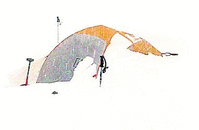 Three Ukrainian mountaineers Vladimir Roshko, Nicholay Shimko and Dmitry Nechiporenko from the city of Sumy have been trapped in a snowdrift on the Mount Blanc since Thursday (11th of January) spending Sunday night, their fifth night outside. Around 13:30 on Monday (17th of January), a PGHM helicopter managed to take off in the direction of the Col de Brenva towards the Mont Blanc to rescue the stranded climbers. Rescuers found the three men at 4300m in good health although somewhat famished!
Three Ukrainian mountaineers Vladimir Roshko, Nicholay Shimko and Dmitry Nechiporenko from the city of Sumy have been trapped in a snowdrift on the Mount Blanc since Thursday (11th of January) spending Sunday night, their fifth night outside. Around 13:30 on Monday (17th of January), a PGHM helicopter managed to take off in the direction of the Col de Brenva towards the Mont Blanc to rescue the stranded climbers. Rescuers found the three men at 4300m in good health although somewhat famished!
Bad weather including strong winds has prevented rescue teams to successfully extract the stranded climbers. The three Ukrainian climbers left Wednesday morning on a ski tour up the col de la Brenva, by Thursday the three men found themselves stranded at 4303 meters due to deteriorating weather conditions. Fortunately the team were well equipped and in good health so decided to set up bivouac.
"The weather conditions were extremely difficult again on Sunday, with cloudy weather and strong winds. But these seasoned mountaineers have high morale and improved weather conditions are announced for late Monday morning" should make a rescue possible says the PGHM in Chamonix. Chamonet.com.
On the way back at Budapest
A Book about Seven Summits issued on Tuvan Language
Elbrus.
The project to conquer the seven highest points of seven continents was started in 2007 with the support of the Prime Minister of the Republic of Tuva Sholban Kara-ool. During next year four Tuvan climbers climbed two of the seven ...
The project to conquer the seven highest points of seven continents was started in 2007 with the support of the Prime Minister of the Republic of Tuva Sholban Kara-ool. During next year four Tuvan climbers climbed two of the seven highest peaks in the world - Elbrus (5,642 m) and Kilimanjaro ( 5895m), where they established national flags of Russia and Tuva. In March of 2009 , three athletes from Tuva climbed the highest peak in South America - Aconcagua (6962 m), dedicating their victory to the 65th anniversary of the Voluntary Entering of the Tuva People's Republic to Russia (noted in October 2009). In June 2010 the project leader Maadyr Khovalyg and women-climber Marianna Surunchal reached the summit of McKinley.
Under the plan, until 2014 Tuva athletes must conquer the highest peak of planet Mount Everest (8848 meters), Vinson Massif (4897 m) in Antarctica and Mount Kosciuszko (2228 m) in Australia. Our friends Maadyr and Marianna will start for Australia in the beginning of next year.
Maadyr Khovalyg (63 years old) is best-known and well-published writer who writes on the Tuvan language. This book devoted to the first three climbs of the project. We are sure that it will be continued….
Preparation for “Earth’s Ring of Fire” Expedition Started
Research and sport expedition “Earth’s Ring of Fire”, aimed at traveling around the globe and following our planet’s volcanic belt, starts in February 2011. The expedition will visit 19 countries: Russia, United ...
Research and sport expedition “Earth’s Ring of Fire”, aimed at traveling around the globe and following our planet’s volcanic belt, starts in February 2011. The expedition will visit 19 countries: Russia, United States of America, Canada, Mexico, Guatemala, Salvador, Nicaragua, Costa Rica, Panama, Columbia, Ecuador, Peru, Chile, Argentina, New Zealand, Australia, Indonesia, Philippines and Japan.
The expedition, aimed at covering over 70 000 kilometers at 5 continents, will have 7 stages, during which participants will permanently travel along the Pacific Ring of Fire – a territory, famous for hosting 75% of Earth’s volcanoes and 90% earthquakes.
Before the start expedition members plant to climb Elbrus and Kazbek peaks, located in Caucasian mountains, to get better acclimatization.
Pacific Ring of Fire
Konstantin Merzhoev – leader of the expedition
Source: Russian Geographic Society
Our congratulations: Quebecer Franñois Langlois conquers the Seven Summits
Elbrus.
A member of 7 Summits Club François Langlois has reached the top of Antarctica's Vinson Massif, marking a decade challenge to climb the seven summits - the highest mountains of each of the seven continents: Mount Aconcagua, ...
A member of 7 Summits Club François Langlois has reached the top of Antarctica's Vinson Massif, marking a decade challenge to climb the seven summits - the highest mountains of each of the seven continents: Mount Aconcagua, Argentina, 2000; Mount Everest, Nepal, 2001, 2009; Mount Logan, Canada/Mount McKinley, U.S., 2003; Mount Elbrus, Russia, 2008; Carstensz Pyramid, Indonesia, 2008, Kilimanjaro, Tanzania, 2009; Vinson Massif, Antarctica, 2010. The glorious mountaineering quest was realised by Langlois with a noble purpose - to raise money for children's charities.
“I was born prematurely at 4 pounds, with underdeveloped lungs. I spent the first 5 weeks of my life in an incubator, dropped to 2 pounds and had multiple blood transfusions, jaundice, basically fighting off a whole slew of illnesses, fighting for my right to stay! 35 years have now gone by and with my fully developed lungs; I had the privilege to set foot a top of the world’s highest mountain; Everest. In those beautiful 15 minutes that I stood there, gazing at our amazing world, I made a promise; to help give back the gift I received. Recently, we found out that the pain in my chest was in fact a 2 pound benign tumour the size of a grapefruit on my left lung. It seems that I have carried this tumour with me since birth and climbed with it over the years. It was with me on Everest. As they removed the tumour, it burst, spilling a pint of fluid outside instead of in my lungs. I was spared from a pulmonary oedema that while on the Everest, would have been fatal. I enjoy with what eyes I see the world today!“ exclaims François Langlois.
Langlois supports, among other, Fondation Centre de cancerologie Charles-Bruneau, Child Haven International, The Montreal Children’s Hospital (McGill University Health Centre), The Make-A-Wish Foundation and World Vision.
Valery Rozov and Red Bull Antarctica: Out of this World!
Famous Russian climber and BASE jumper Valery Rozov accomplished another milestone in his extraordinary career with the first ever jump from one of Antarctica's most inhospitable mountains. 'I felt like an astronaut in outer space' – ...
Famous Russian climber and BASE jumper Valery Rozov accomplished another milestone in his extraordinary career with the first ever jump from one of Antarctica's most inhospitable mountains.
'I felt like an astronaut in outer space' – Valery Rozov
At 2931 metres high, Mount Ulvetanna loomed frighteningly large as Rozov led an eight-strong team on Red Bull Antartica, bracing themselves for temperatures as low as -30°C.
After two weeks of preparation, Rozov climbed the face of the Ulvetanna together with his climbing colleague, Alexander Ruchkin, and mountain photographer, Thomas Senf. With his wingsuit on, he then flew for 45 seconds down the face of the mountain before opening his parachute and landing safely.
“It was like a journey to another planet," he said. “It’s deeply satisfying and has given me a long and lasting feeling of happiness."
Not one to rest on his laurels, however, Rozov was at it again soon afterwards.
With the plane home delayed, there was nothing else for it but to climb some more mountains as Rozov ascended the Tungespissen and the Holtanna – the only mountain in the Antarctic that had previously been used by a BASE jumper.
The Muscovite has attracted attention with his spectacular jumps in recent years, including a leap from the highest point of Mount Elbrus in Europe and more recently into an active volcano on Kamchatka in eastern Russia.
We're quite sure you won't have heard the last of Valery Rozov so bookmark redbull.com to find out about his next adventure.
by Chris Stanton
